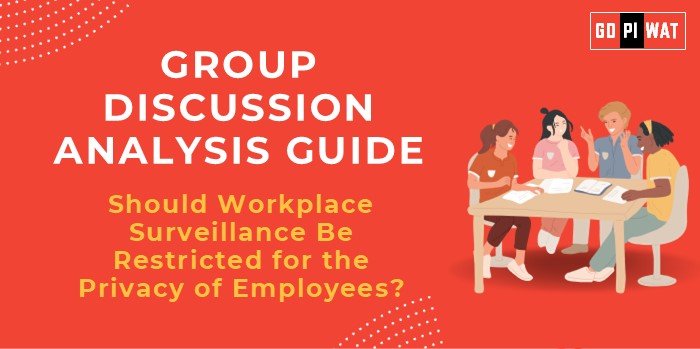📋 Group Discussion Analysis Guide: Should Workplace Surveillance Be Restricted for the Privacy of Employees?
🌐 Introduction to the Topic
- Opening Context: In an era of rapid technological adoption, workplace surveillance has emerged as a double-edged sword. While organizations employ surveillance for productivity, security, and compliance, it raises critical concerns about employee privacy and autonomy.
- Topic Background: Workplace surveillance refers to the use of monitoring tools—like CCTV cameras, productivity software, and keystroke trackers—to oversee employees’ work activities. Recent advancements in Artificial Intelligence (AI) and data analytics have intensified debates over its ethical and legal boundaries.
- Relevance: This discussion is crucial for businesses navigating between fostering trust and ensuring operational efficiency.
📊 Quick Facts and Key Statistics
- 📉 68% of employees feel uneasy about constant workplace monitoring (Gartner, 2023).
- 📈 20% productivity increase observed in organizations using surveillance tools effectively.
- 💻 45% of companies monitor employee emails, screen time, and communications (Pew Research, 2023).
- 📜 Legal Landscape: GDPR in Europe restricts excessive monitoring, while U.S. states have different regulations.
- 😟 Psychological Impact: Increased surveillance leads to higher stress and lower job satisfaction (Forbes, 2023).
🌟 Stakeholders and Their Roles
- 🏢 Employers: Ensuring productivity, data security, and compliance while balancing trust and autonomy.
- 👩💼 Employees: Advocating for privacy, workplace comfort, and protection against micromanagement.
- 🏛️ Government Bodies: Framing laws to regulate surveillance and employee rights.
- 💻 Tech Companies: Developing ethical monitoring tools and balancing surveillance features with privacy considerations.
- ✊ Labor Unions: Safeguarding employee rights and pushing back against intrusive practices.
🏆 Achievements and Challenges
Achievements
- ✔️ Productivity Gains: Surveillance tools help employers monitor work efficiency, leading to improved outputs.
- 🔒 Workplace Safety: Monitoring can prevent harassment, theft, or safety violations.
- 📜 Compliance: Ensures adherence to company policies and legal frameworks.
Challenges
- ⚠️ Privacy Invasion: Excessive monitoring infringes on employees’ basic rights and autonomy.
- 😟 Psychological Impact: Constant surveillance leads to distrust, stress, and reduced morale.
- ⚖️ Ethical Concerns: Questions arise about informed consent and misuse of surveillance data.
Global Comparisons
- 🇪🇺 Europe: The GDPR sets strict guidelines for employee monitoring, ensuring data protection and transparency.
- 🇺🇸 U.S.: Largely employer-driven with varying state laws; regions like California are introducing privacy protections.
- 🇨🇳 China: Extensive surveillance practices focus on maximizing productivity but raise significant privacy concerns.
Case Study
Amazon Warehouses: The company faced criticism for its intense surveillance systems, including productivity trackers and mandatory monitoring software, which reportedly caused stress and dissatisfaction among employees.
📚 Structured Arguments for Discussion
- 🟢 Supporting Stance: “Workplace surveillance ensures accountability, enhances productivity, and prevents misconduct—ultimately benefiting both employers and employees.”
- 🔴 Opposing Stance: “Excessive workplace surveillance compromises employee privacy, undermines trust, and negatively impacts mental health, outweighing its benefits.”
- ⚖️ Balanced Perspective: “While surveillance can improve security and efficiency, it must be transparent, regulated, and considerate of employees’ privacy rights.”
💡 Effective Discussion Approaches
- Opening Approaches:
- 📊 Data-Driven Start: “With 68% of employees expressing discomfort about surveillance, businesses must re-evaluate its long-term impact on workplace trust and morale.”
- 🤔 Ethical Angle: “The line between monitoring for productivity and infringing on privacy is thin—finding the balance is essential for ethical business operations.”
- Counter-Argument Handling:
- Challenge: “Productivity improves with surveillance.”
- Response: “Short-term gains may exist, but excessive monitoring lowers morale, trust, and long-term job satisfaction.”
- Challenge: “Monitoring ensures safety and compliance.”
- Response: “This can be achieved through transparent policies and non-intrusive technologies.”
📊 Strategic Analysis of Strengths and Weaknesses
- 🌟 Strengths: Increased productivity, workplace safety, policy enforcement.
- ⚠️ Weaknesses: Privacy violations, trust erosion, legal ambiguity.
- 📈 Opportunities: Adoption of ethical monitoring frameworks, employee-inclusive policies.
- ⚡ Threats: Legal challenges, employee resistance, negative workplace culture.
🎓 Connecting with B-School Applications
- 📋 Real-World Applications:
- Exploring HR strategies for ethical surveillance in organizations.
- Analyzing case studies on surveillance and its impact on employee engagement.
- Developing frameworks for balancing productivity with employee trust.
- 📋 Sample Interview Questions:
- “How can businesses balance workplace efficiency with employee privacy?”
- “What ethical concerns arise from the adoption of AI-driven surveillance tools?”
- 💡 Insights for B-School Students:
- Understanding the role of technology in HR policies.
- Analyzing the impact of surveillance on employee retention and satisfaction.
- Exploring global legal frameworks and corporate strategies for responsible monitoring.


